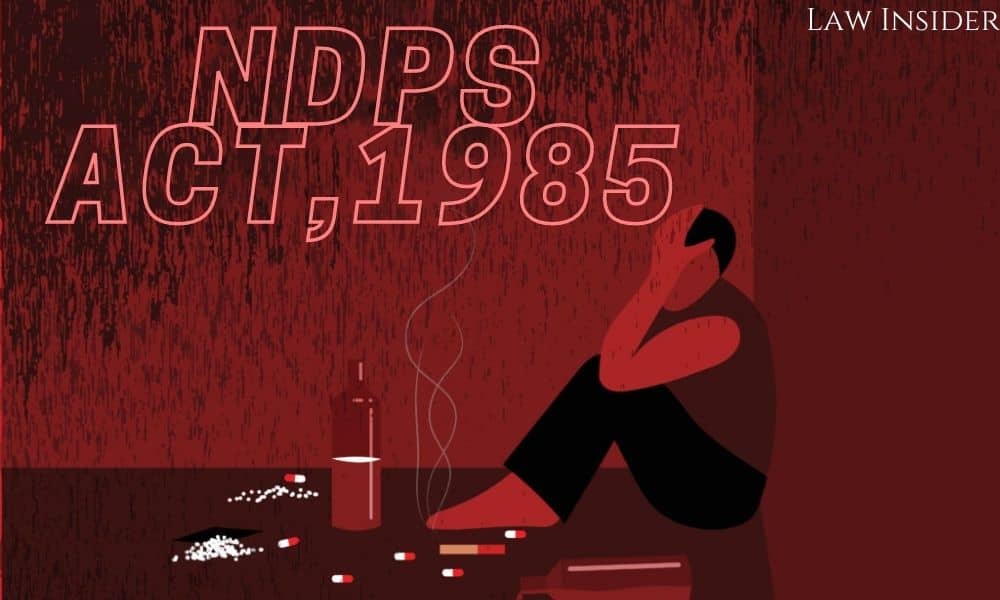The Narcotic Drugs and Psychotropic Substances Act (NDPS Act) is an important legislation in India that aims to control and regulate the use, production, and trafficking of narcotic drugs and psychotropic substances. The Act was enacted in 1985 to consolidate and amend the law related to narcotic drugs, providing stringent provisions for the control and regulation of operations related to these substances. It also implements the provision of international conventions on narcotic drugs and psychotropic substances.

The NDPS Act prohibits various activities related to narcotic drugs and psychotropic substances, including production, manufacturing, cultivation, possession, sale, purchase, transport, storage, and consumption. It defines various offences and prescribes penalties for contraventions, including enhanced punishment for repeat offenders and the death penalty for certain offences after a previous conviction.
The Act establishes authorities and officers at both the Central and State Government levels to enforce its provisions, including the Narcotic Drugs and Psychotropic Substances Consultative Committee. The National Fund for Control of Drug Abuse is established to address drug abuse issues.
The NDPS Act plays a crucial role in combating drug abuse and maintaining public health and safety.
How is the NDPS Act enforced in India?
The NDPS Act, enacted through legal provisions and judicial processes, regulates the use of Narcotic Drugs in India.
In India, the NDPS Act, of 1985 is implemented through legislative measures, law enforcement organisations, and legal procedures.
The following are the main facets of its enforcement:
1. Law Enforcement authorities:
◦ The NDPS Act gives different law enforcement authorities at different levels distinct duties:
▪ Central Bureau of Narcotics (CBN):

Charged with authorising and overseeing the production of cannabis and opium poppies.
The Narcotics Control Bureau (NCB) is the principal organisation implementing the NDPS Act nationwide. It looks into instances involving the manufacture, trafficking, and misuse of drugs.
1. State Police: Uphold the Act in the states in which they are assigned.
2. Customs Department: Keeps an eye on foreign borders to stop drug smuggling.
3. Central Excise Department: Oversees the manufacture of chemicals under control.
4. National and Local
5. State and Central Intelligence Agencies: Compile information on actions relating to drugs.
- Investigation and Detection: ◦ Informants, intelligence networks, and surveillance are some of the ways that law enforcement authorities learn about drug-related activity.
2. They carry out searches, seizures, and raids to capture criminals engaged in drug manufacture, trafficking, or possession.
3. Arrest and Seizure:
◦ When an offence is discovered, law enforcement agents take associated materials, narcotics, and psychotropic substances into custody and arrest suspects.
◦ Forensic analysis determines the nature and amount of the seized objects.
4. Legal Process:
◦The court brings the arrested individuals before it. A trial, bail hearings, and sentencing are all part of the legal process that comes next.
After the prosecution delivers its case, the defence has the opportunity to refute the charges.
5. Courts and Sentencing:
The special courts that designate under the NDPS Act have handled Drug-related cases.
1. The Act stipulates severe punishments, such as fines and jail time.
2. Severe violators might receive harsher penalties.
3. some crimes carry a death sentence (large-scale trafficking, for example).
6. Property Forfeiture:
The NDPS Act allows for the forfeiture of property obtained from drug trafficking. Courts may seize assets connected to drug-related offences by court order.
7. Awareness and Prevention:
◦ Awareness programmes inform the public about the risks associated with drug addiction in conjunction with law enforcement.
Rehabilitation centres provide addicts receiving therapy and counselling.
8. International Collaboration:
India works with other nations to combat the trafficking of drugs across international borders.
◦ It exchanges intelligence and takes part in international forums.
In summary, the NDPS Act’s enforcement involves a coordinated effort by law enforcement agencies, legal processes, and public awareness initiatives to curb drug abuse and trafficking in India.
What is the punishment for drug possession under this act?

The NDPS Act, enacted in 1985, imposes severe penalties for drug possession, focusing on the illegal use of narcotic drugs.
1. Small Quantities:
It is likewise illegal to possess small amounts of psychotropic or narcotic drugs for personal use.
◦ Penalties for possessing tiny amounts of drugs vary depending on the substance in question but usually involve jail time and fines.
2. Particular chemicals:
a) The Act places chemicals in several schedules (Schedules I through IV).
b) rug possession, such as heroin, cocaine, and LSD, is punishable by harsh imprisonment for a minimum of 10 years and a fine of at least ₹1 lakh (Indian Rupees).
c) Possession of drugs included in Schedule III and IV (such as cannabis, hashish, and morphine) carries a minimum one-year jail sentence and a fine of ₹10,000.
3. Aggravating Factors:
◦ The penalty is harsher if the offence includes commercial volumes.
◦ Penalties for repeat offenders are harsher.
4. Death sentence:
The NDPS Act allows for the death sentence in some circumstances, such as the repeated trafficking of significant quantities.
5. Judicial Discretion:
Depending on the specifics of each case, courts are free to choose the appropriate sentence.
Keep in mind that the NDPS Act intends to prevent drug abuse and safeguard public health and that possessing drugs is a serious offence. Seek out expert support and assistance if you or anybody you know is experiencing substance abuse problems.
Courts have the discretion to select a suitable sentence based on the unique circumstances of each case. When determining the sentencing, multiple elements come into play, such as the offender’s prior criminal record and the nature, amount, and purpose of the substance involved. It is important to remember that the NDPS Act aims to combat drug abuse and protect public health, considering drug possession as a significant offence. If you or someone you know is struggling with substance abuse issues, it is advisable to seek professional guidance and support.
Can a person be released on bail after being arrested under the NDPS Act?
The NDPS Act, of 1985, imposes stringent bail provisions for individuals arrested for narcotic drugs due to the seriousness of these offences.
1. Section 37 of the NDPS Act:
Under this section, bail may only be granted if the accused is found not guilty of the offence, the court is satisfied that there are reasonable grounds to believe that the accused is not guilty, and the accused is unlikely to commit any crimes while on bail.
This applies to offences involving “commercial quantities” (e.g., more than 1 kg of hashish) or serious offences like financing illicit traffic or harbouring offenders.
2. Non-Bailable Offences:
Under the NDPS Act, drug-related offences are normally cognizable and not subject to bail; however, bail may be granted in certain circumstances as specified by Acts.
3. specific Provision for Bail:
◦ The usual rules regarding bail under the Code of Criminal Procedure (CrPC) do not apply since the NDPS Act specifies a specific provision for bail.
◦ The primary goal of the Act is to establish strict guidelines for managing and overseeing activities about opioids and psychoactive substances.
4. High Court’s discretion:
◦ Subject to the restrictions outlined in Section 37 of the NDPS Act, the High Court may issue bail under Section 439 of the CrPC.
◦ Section 37’s non-obstante clause emphasises the purpose of the Act by limiting the authority to grant bail.
5. Judicial Caution:
◦ The court’s discretionary power to order someone’s release is more stringent and should be used carefully for offences punishable under Section 37 of the Act.
◦To bail granted under Section 439 of the CrPC, NDPS bail is contingent upon certain requirements3.
The NDPS Act allows for bail, but it is only given after an evaluation of the crime and the accused’s propensity for future offences.
The Act places a high priority on combating drug misuse and trafficking in the nation.
What is the difference between small and commercial quantities?
The Narcotic Drugs and Psychotropic Substances (NDPS) Act categorizes small quantities and commercial quantities of psychotropic substances.
1. Small Quantity:

◦ Poppy Straw: Fine up to ₹10,000 (about US$130), or face harsh imprisonment for up to a year or both.
1. A fine of up to ₹1 lakh and a term of harsh imprisonment of up to ten years is imposed for quantities larger than small but less than commercial.
2. The quantity involved also affects the penalties for offences using cocaine, opium, cannabis, and other substances.
3. The punishment for repeat violations is 1.5 times higher.
4. The minimum sentence for commercial amounts is ten years of hard labour, with a maximum sentence of twenty years.
2. Commercial Quantity:

denotes the presence of a greater quantity of drugs; the penalties are harsher for commercial amounts. The NDPS Act seeks to safeguard the general public’s health and control drug-related activities.
Recall that the NDPS Act’s penalty harshness is largely based on the distinction between small and commercial amounts.



